⑨
疑觋一忆一钆㈣淋
茎蒜一
隶劫大·莹
硕士学位论文
基于视频图像的雾天能见度检测
方法研究与实现
研究生姓名:
毯盛
导帅姓名: 路丛!遮夔援
申请学位类别
工芏亟±
学位授予单位
盔亩盔堂
级学科名称 控剑抖芏与王猩
论文答辩日期 垫!§生!旦!旦
级学科箱称撞测撞查里自动丝苤量学位授予Ij期 !Q1 3生 且
旦
答辩委员会{二席 签釜国 夔攫
评
l剜
人 周查基夔授
筮查良夔授
2013年3月28
�
饿
隶韵太t尝硕士学位论文
基于视频图像的雾天能见度检测
方法研究与实现
研究生:耿威
导师:路小波教授
专业:检测技术与自动化装置
东南大学自动化学院
二零壹叁年月
�
RESEARCH ON FOG VISIBILITY
DETECTION METHOD BASED ONⅥDEO
IMAGE PROCESSⅢG
咖7Ⅲ3Ⅲ4㈣Z洲Y
㈨3Ⅲ2洲6
AThesis Submitted to
Southeast UniVers埘
For me Academic Degree of Master of Engineering
BY
GENG W.ei
Supervised by
Pro£LU Xiao.bo
School ofAutonlation
Soutlleast UniVers时
March 2013
�
东南大学学位论文独创性声明
本人声明所呈交的学位论文是我个人在导师指导下进行的研究工作及取得的研究成
果。尽我所知,除了文中特别加以标注和致谢的地方外,论文中不包含其他人已经发表
或撰写过的研究成果,也不包含为获得东南大学或其它教育机构的学位或证书而使用过
的材料。与我一同工作的同志对本研究所做的任何贡献均已在论文中作了明确的说明并
表示了谢意。
研究生签名:
东南大学学位论文使用授权声明
东南大学、中国科学技术信息研究所、国家图书馆有权保留本人所送交学位论文的
复印件和电子文档,可以采用影印、缩印或其他复制手段保存论文。本人电子文档的内
容和纸质论文的内容相一致。除在保密期内的保密论文外,允许论文被查阅和借阅,可
以公布(包括刊登)论文的全部或部分内容。论文的公布(包括刊登)授权东南大学研究生
院办理。
研究生签名:耍丝奎导师签名:
期: 巡
日
�
摘要
摘要
随着信息技术的发展,计算机视觉作为一种新的学科逐渐受到重视并发展起来,能
见度检测作为计算机视觉发展中的一个方向,对交通安全方面有很重要的意义。本文围
绕雾天等级检测和能见度检测两个方面展开研究。在雾天等级检测研究方面,提出一种
基于HSV颜色直方图的雾天等级检测方法。在能见度检测方面研究一种基于畸变校正的
视频图像距离转换模型,提出一种最远可视点的检测方法,通过距离转换模型,实现能
见度检测。主要研究工作如下:
(1)提出一种基于图像HsV颜色直方图的雾天等级检测方法。该方法利用各种天
气条件下彩色图像H(色相)、s(饱和度)、v(亮度)量的直方图特征,对不同能见
度的雾天进行分类,实现雾天等级检测。实验结果表明,该方法能够快速对雾天情况做
定性的判断,可以得到比较好的定性检测结果。
(2)研究一种基于畸变校正的视频图像距离转换模型。该方法根据直线透视投影保
持同素性,通过LM法优化标定出畸变模型系数和摄像机主点坐标,然后校正成像点,
使其满足针孔映射关系;再根据射影几何中消失点与光心的连线平行于该平行直线的性
质以及摄像机成像原理,利用矩形图样的边长信息,线性求解摄像机内外部参数,完成
摄像机标定,建立图像距离转换模型。该方法减小了标定误差,降低了标定的复杂度。
实验结果验证了本方法的准确性。
(3)提出一新的基于视频图像处理的能见度检测方法。该方法首先根据图像中每
一点与其周围八邻域点灰度对比度,确定图像的对比度特征,若该特征满足阈值条件,
则检测出图像的最远可视点;对于不满足阈值条件的情况,利用逐行对比度模型检测出
最远可视点。进一步,利用距离转换模型将图像中最远可视点转换为实际距离,即得到
能见度值。实验结果表明,该方法具有很好的检测效果。
(4)设计了能见度检测系统。利用摄像机和计算机组成能见度检测系统的硬件部
分,并采用VC++6.0、MFC库以及OpenCV函数库相结合的方式编程实现了本文所介
绍的能见度检测系统的软件部分。完成系统功能实现,经测试,该系统能够完成相应功
能并具有较好的性能。
关键词:能见度检测,畸变校正,图像距离转换模型,雾天等级,最远可视点
�
AbstraCt
ABSTRACT
With me deVelopment of info衄ation tecllllology,co叫)uter Vision h2us gradually be
tal(en seriously and developed as a new disciDline.Ⅵsibilit'I,detection,aS a diI.ection of me
development of coInputer Vision,haS iInponamt si嘶ficance to the仃a伍c safety.711lis p印er
conducted a studV踟und fog 1evel detection and visibilit、r detection.In the research of fog
level detection'this paper proposed a fog level detection metllod Which is baSed on HSV
color histogram.In the inspection of the visibili够,tMs paper foeuses on the problem of t11e
Visibility detection w11ich is based on c锄em self.calibration alld video con缸aSt aIld f啪lest
vie、)17poim detection.Here are廿1e main works of thjs p印er.
(1)Tbjs paper proposed a fog level detection metllod which is baSed on HSV color
11isto脚。We research the classification method by using the MSto灯锄featllres of廿1e hue
(H),saturation(S),aIld valueⅣ)info珊ation of me image and acllieve the fog Ievel detection.
Realize fog level detection by claussi母ing difrerent fog.The experimen_tal results show that
this metllod can make qualitatiVe judgment quicl(1y and get goof qualitative results.
(2)111is paper researched a Video image distance衄lsfo册ation model based on t11e
rec胁guIar pattem,wllich haS舭abiI时of defom埘collrection.First,we used舭single
par锄eter model to co珊ect lens distortion.ARer detemli血g the coordinates of tlle principal
point,we corrected imagiIlg po硫t0 satis匆t|le conditions of pinhole imaging model.Using
the perspectiVe transfomlation of the photography geometIy,、Ⅳe solVe tlle intemal aIld
extemal parameters of me c锄era according to me vallis量ling point f.oming by the rectaIlgular
pa仕em aIld the lengm of rectaIlgular pattem.T11is memod reduces tlle distortion impact to a
la略e extent.F删lemore,it does not require the meaSurements of extemal p猢eters of me
c锄era auld the absolute distaIlce be铆een the ca】ibration points.And it is eaSy to realize.
Exp甜mental results show th越the memod has a good e自睹ct.
(3)This paper proposed a new visibili够detection method baSed on Video image.111is
meⅡlod first builds the fog如rthest Viewpoint detection model by comparing廿le铲ay f-eatllre
of eaCh point to its surrourlding eight points in the fog image.h call detect the如rtllest
Viewpoint of tlle fog image and,then,get the visibili够value by distallce trallsf0姗融ion
model.Experimen_taI results show mat t11e detection method haS a good ea’ect.
(4)We design me Visibility detection systems.The hardware of me Visibilit),detection
systems is made up of a c锄era aIld a computer.7rhe sofhⅣare is based on VC++6.0,MFC
library and 0penCV libra彤AccordiIlg toⅡle test,the system is stable aJld accurate in tlle
visibil时detection section.
Key words:Ⅵsibil时detection,Defom时co玎ection,C锄era calibration distaIlce
仃ansfbnnation model,Fog level,Furthest vie、vpoint
�
目录
目 录
摘曼荽……………………………………………………………………………………………………………….I
ABSTRACT……………………………………………………………………………………………………¨
E|录…………………………………………………………………………………………………………..1II
第一章绪论…………………………………………………………………………1
1.1研究背景及意义……………………………………………………………………………………1
1.2国内外基于视频图像的能见度检测技术研究现状………………………………………………2
1.3本文主要研究内容…………………………………………………………………………………4
第二章基于图像HsV颜色直方图的雾天等级检测方法研究…………………………5
2.1常用的雾天等级检测方法…………………………………………………………………………5
2.2基于HSV颜色直方图的雾天等级检测………………………………………………………….6
2.2.1 HSV色彩空间简介……………………………………………………………………………6
2.2.2不同天气下的HsV直方图及特征提取………………………………………………………7
2.2.3雾天等级检测……………………………………………………………………………….10
2.3实验结果及分析………………………………………………………………………………13
2.4本章小结……………………………………………………………………………………….13
第三章基于畸变校正的图像距离转换模型研究……………………………………14
3.1摄像机标定的基本原理…………………………………………………………………………14
3.1.1参考坐标系…………………………………………………………………………………14
3.1.2摄像机模型介绍……………………………………………………………………………16
3.1.3需要标定的参数……………………………………………………………………………18
3.2摄像机标定方法介绍……………………………………………………………………………18
3.2.1传统摄像机标定方法………………………………………………………………………18
3.2.2摄像机自标定方法…………………………………………………………………………19
3.3基于畸变校正的图像距离转换模型建立……………………………………………………….20
3.3.1基于矩形图样的摄像机标定……………………………………………………………….20
3.3.2畸变校正模型的建立………………………………………………………………………22
3.3.3距离转换模型的建立……………………………………………………………………….25
3.3.4算法流程图………………………………………………………………………………….26
3.4实验结果………………………………………………………………………………………….27
3.5本章总结…………………………………………………………………………………………28
第四章基于视频图像处理的能见度检测方法研究………………………………….29
4.1引言………………………………………………………………………………………………………………………………29
4.2图像的预处理……………………………………………………………………………………30
4.2.1道路背景提取………………………………………………………………………………30
4.2.2道路分割……………………………………………………………………………………32
4-3能见度检测方法…………………………………………………………………………………38
4.3.1算法原理……………………………………………………………………………………38
4.3.2基于图像对比度的能见度值检测…………………………………………………………40
4.4能见度检测结果及分析…………………………………………………………………………46
4.5本章小结…………………………………………………………………………………………48
第五章能见度检测系统设计与实现……………………………………………….49
5.1系统软硬件环境…………………………………………………………………………………49
�
目录
s.1.1系统硬件……………………………………………………………………………………49
5.1.2软件开发环境………………………………………………………………………………50
5.2软件系统结构设计……………………………………………………………………………….51
5.3软件实现………………………………………………………………………………………….52
5。3.1图像读入及预处理模块…………………………………………………………………….52
5.3.2雾天等级检测模块…………………………………………………………………………54
5.3.3图像距离转换模型建立模块……………………………………………………………….55
5.3.4能见度检测模块…………………………………………………………………………….57
5.4系统测试…………………………………………………………………………………………59
5.4.1系统功能测试………………………………………………………………………………59
5.4.2系统性能测试……………………………………………………………………………….62
5.5本章小结…………………………………………………………………………………………62
第六章总结与展望………………………………………………………………….63
6.1总结………………………………………………………………………………………………………………………………63
6.2展望………………………………………………………………………………………………………………………………63
墅炙谢…………………………………………………………………………………………………………….6s
参考文献………………………………………………………………………………66
作者在学期问的科研成果……………………………………………………………69
V
�
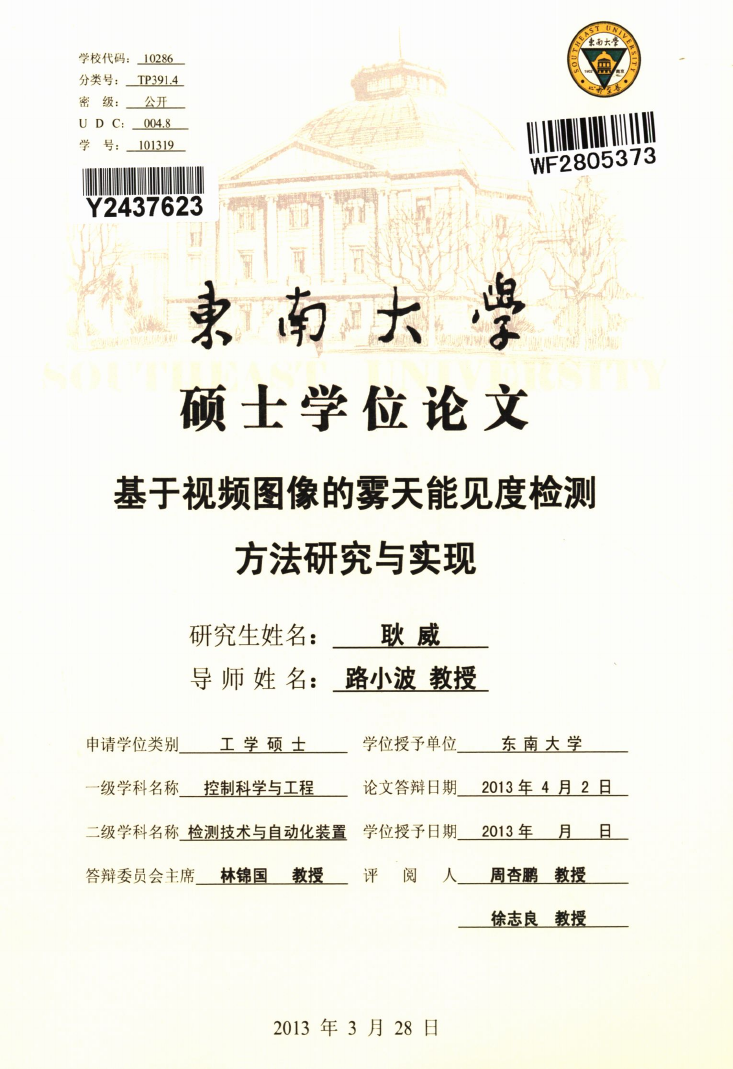
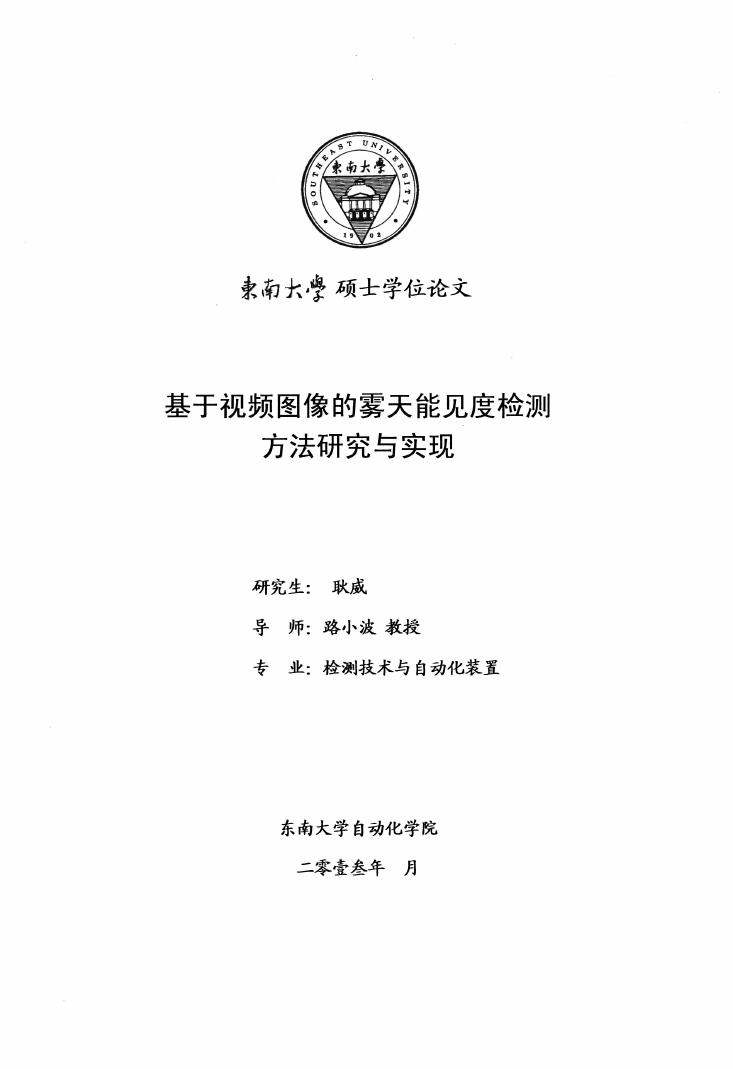
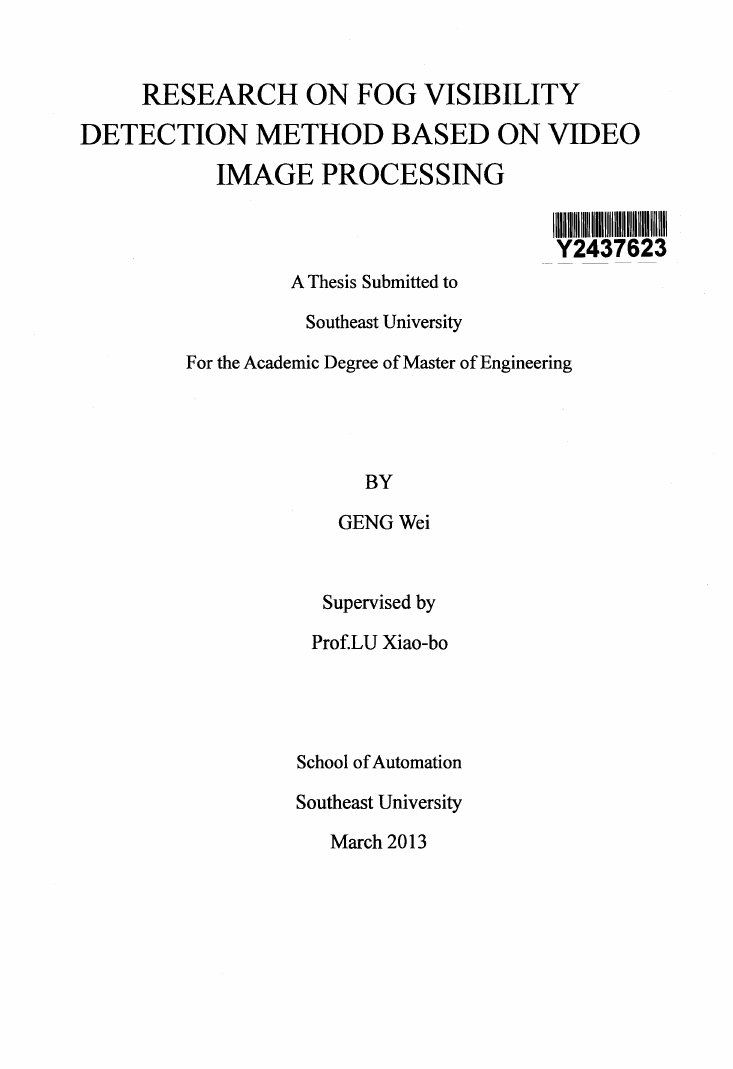
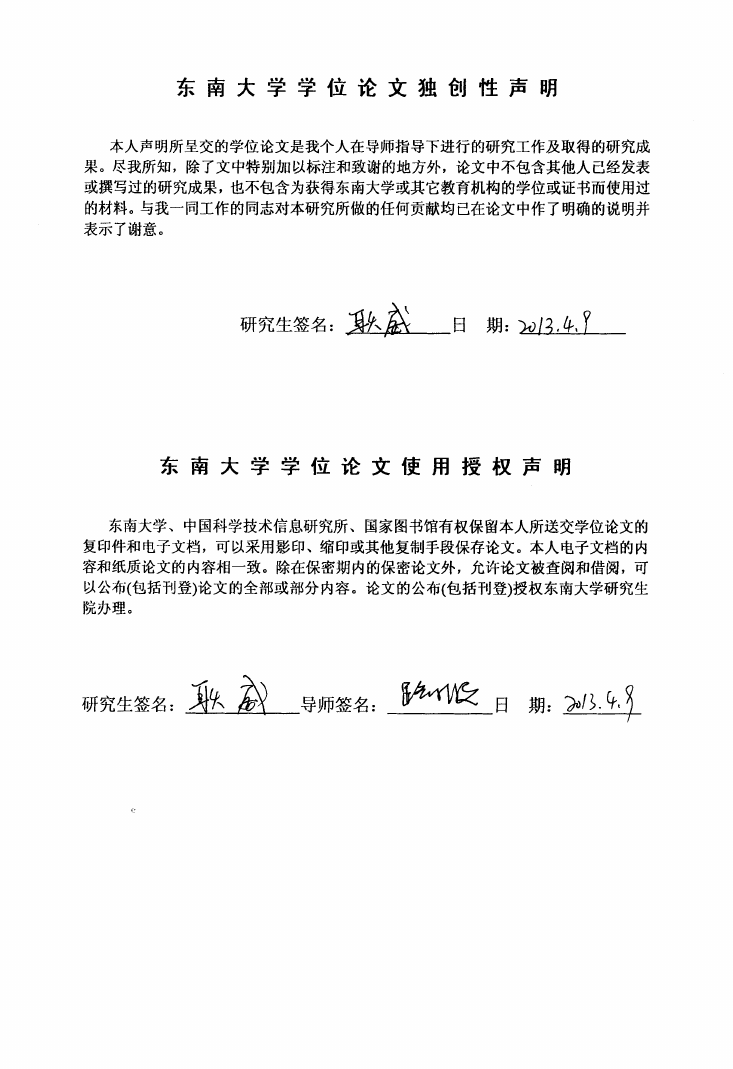
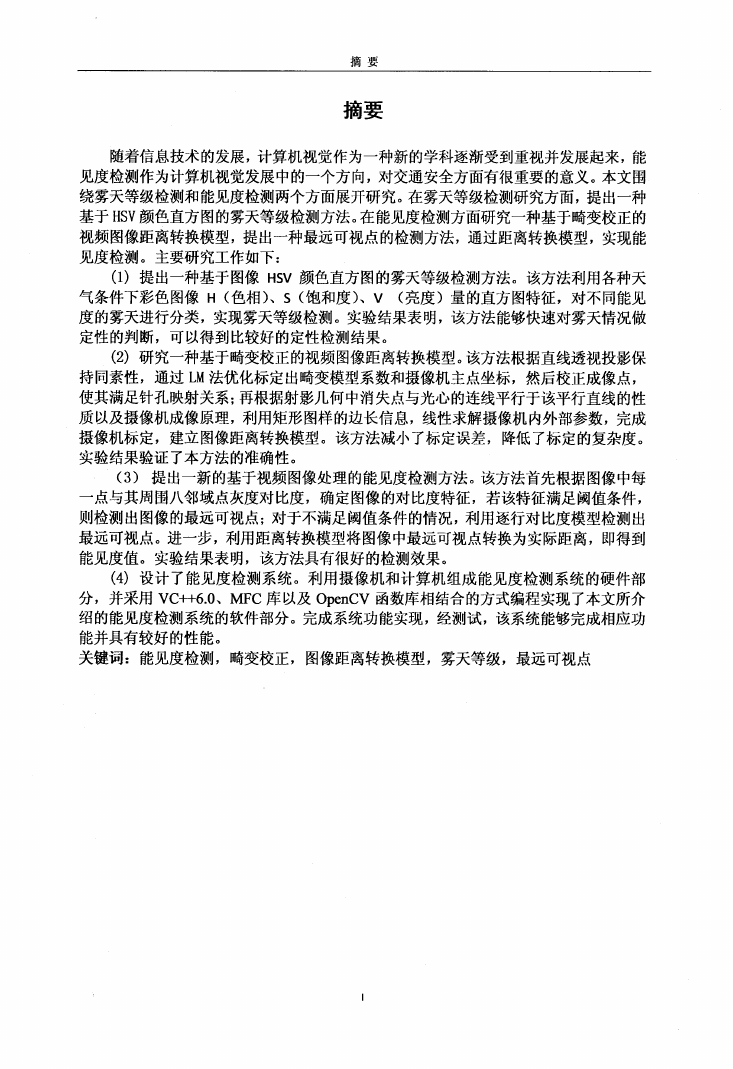
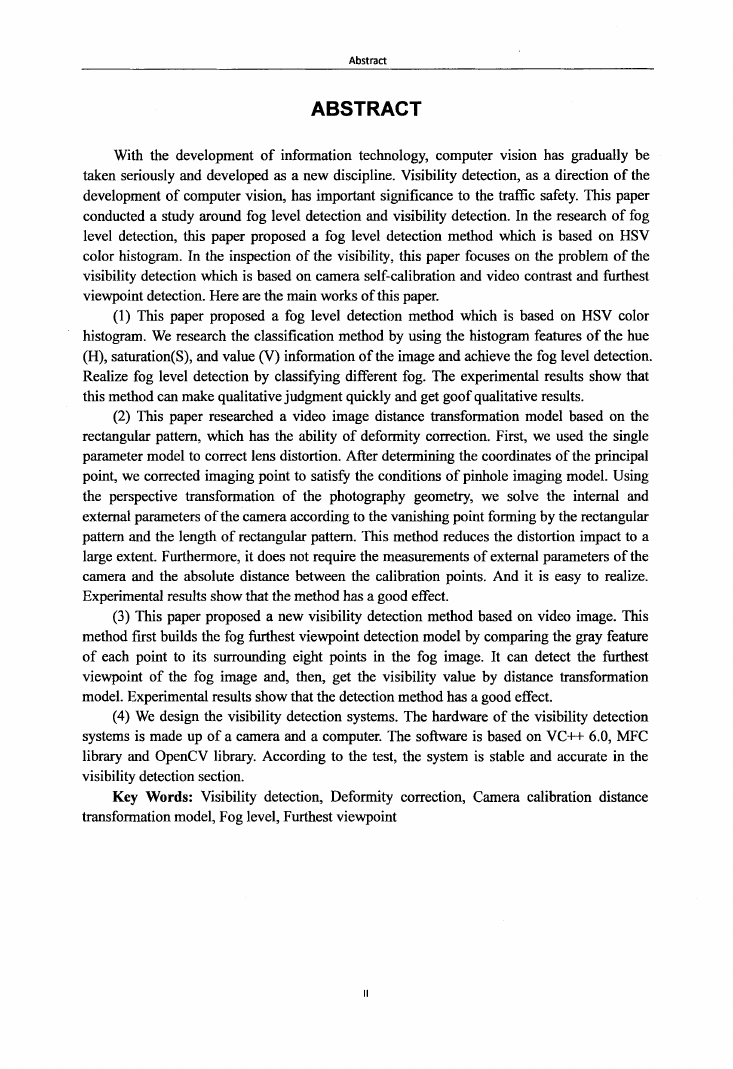
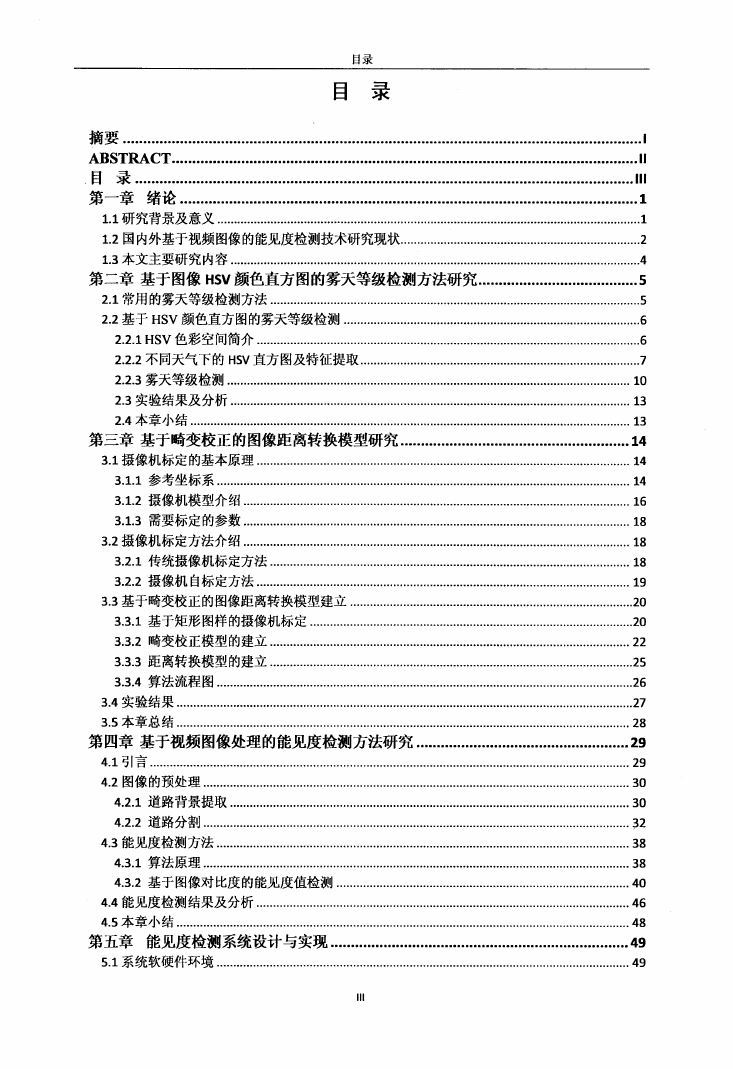









 2023年江西萍乡中考道德与法治真题及答案.doc
2023年江西萍乡中考道德与法治真题及答案.doc 2012年重庆南川中考生物真题及答案.doc
2012年重庆南川中考生物真题及答案.doc 2013年江西师范大学地理学综合及文艺理论基础考研真题.doc
2013年江西师范大学地理学综合及文艺理论基础考研真题.doc 2020年四川甘孜小升初语文真题及答案I卷.doc
2020年四川甘孜小升初语文真题及答案I卷.doc 2020年注册岩土工程师专业基础考试真题及答案.doc
2020年注册岩土工程师专业基础考试真题及答案.doc 2023-2024学年福建省厦门市九年级上学期数学月考试题及答案.doc
2023-2024学年福建省厦门市九年级上学期数学月考试题及答案.doc 2021-2022学年辽宁省沈阳市大东区九年级上学期语文期末试题及答案.doc
2021-2022学年辽宁省沈阳市大东区九年级上学期语文期末试题及答案.doc 2022-2023学年北京东城区初三第一学期物理期末试卷及答案.doc
2022-2023学年北京东城区初三第一学期物理期末试卷及答案.doc 2018上半年江西教师资格初中地理学科知识与教学能力真题及答案.doc
2018上半年江西教师资格初中地理学科知识与教学能力真题及答案.doc 2012年河北国家公务员申论考试真题及答案-省级.doc
2012年河北国家公务员申论考试真题及答案-省级.doc 2020-2021学年江苏省扬州市江都区邵樊片九年级上学期数学第一次质量检测试题及答案.doc
2020-2021学年江苏省扬州市江都区邵樊片九年级上学期数学第一次质量检测试题及答案.doc 2022下半年黑龙江教师资格证中学综合素质真题及答案.doc
2022下半年黑龙江教师资格证中学综合素质真题及答案.doc